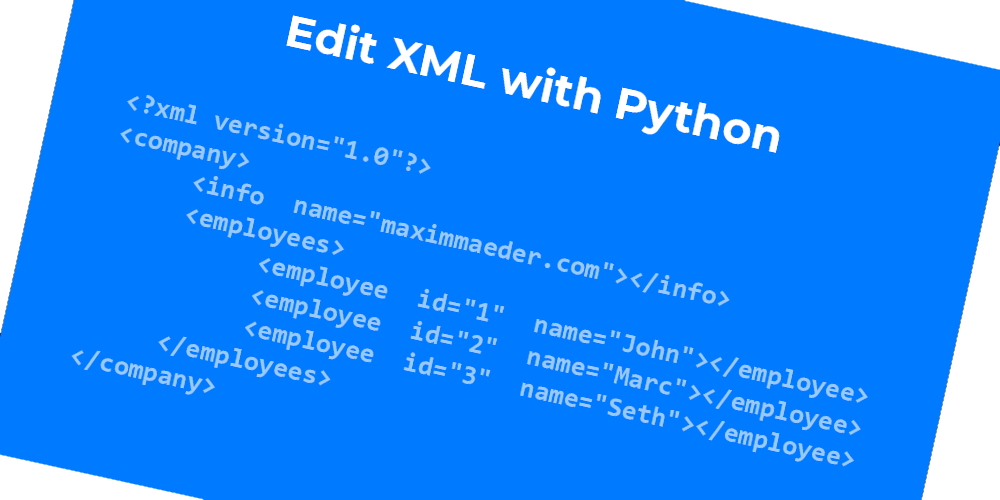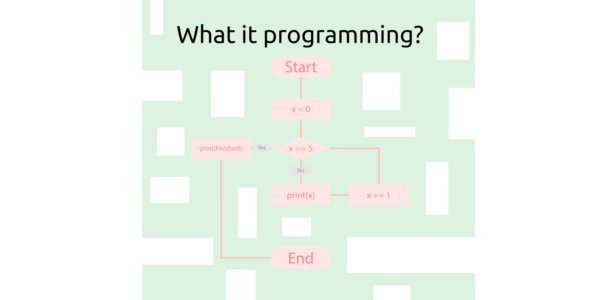
Edit XML with python
Today we learn how to edit XML files with python. To do this we use the xml.dom.minidom class from python. We don’t have to install it because it comes with python. We will learn how to parse, get and set elements and attributes and how to save XML in this article.
¶XML File
In the following code block, you see the content of the XML file. We will use this in the other code blocks of this little tutorial so keep it in mind.
<?xml version="1.0"?>
<company>
<info name="maximmaeder.com"></info>
<employees>
<employee id="1" name="John"></employee>
<employee id="2" name="Marc"></employee>
<employee id="3" name="Seth"></employee>
</employees>
</company>
¶Parsing XML with xml.dom.minidom
To parse an XML file or XML string we import minidom from xml.dom.
from xml.dom import minidom
This module then has a parse() function which gets a file path and it will return document objects which we will use from now on.
# the parse function returns the Document Objects
# parseString is also possible
doc = minidom.parse('file.xml')
¶Get elements and attributes
Let us start by getting elements and attribute values from them. To get an element or there I say a list of the element we need the getElementsByTagName() function which returns as the function says a list of all elements with the specified tag name.
In our case, this is the employees tag which has all the employee tags as children. We get the first item of the list with [0] because it will always return a list even if it has only one item.
# Get elements with getElementsByTagName function
# Return list of elements
employees = doc.getElementsByTagName('employees')[0]
After that, we use this variable which contains a so-called node which is just one tag. We can also use the getElementByTagName() function on this object to get nodes with the tag name which are children of this node.
We loop through these.
# Loop through the employee tags which are within the emplyees tag
for i in employees.getElementsByTagName('employee'):
In the loop, we continue by getting the value of the id and name attributes with the getAttribute() method of the node class. If the attribute does not exist it will simply return "".
# Get the value of their id and name attributes
id = i.getAttribute('id')
name = i.getAttribute('name')
Last but not least we print out these two pieces of information in a nicely formatted string.
# Print them
print(f'{id} : {name}')
running the code will result in this.
1 : John
2 : Marc
3 : Seth
Now you know how to get elements and attributes. In the next part, we see how to create elements and set their attributes.
¶Set elements and attributes
Now we will look at how to make elements and set/add attributes. We insert this code in the loop we have created above.
We start with the attributes because it is really easy, we just call the setAttribute() method on the node and we give it the attribute name and the value. You see below we set the password for each employee to 000000. If the attribute does not exist it will simply add it.
i.setAttribute('password', '000000')
To make a new element we need to do two things. First, we create a new element with the createElement() method on the document object.
# Make a new element / node
newNode = doc.createElement('salary')
And then we append the resulting element to the node of our choice with the appendChild() method.
# append it to this element / node
i.appendChild(newNode)
After the loop, we also add a print statement with doc.toxml() so we see what the new structure looks like.
print(doc.toxml())
running the code will result in something like this. As you see each employee now has a password and an empty salary tag as a child. But this will not be saved.
<?xml version="1.0" ?><company>
<info name="maximmaeder.com"/>
<employees>
<employee id="1" name="John" password="000000"><salary/></employee>
<employee id="2" name="Marc" password="000000"><salary/></employee>
<employee id="3" name="Seth" password="000000"><salary/></employee>
</employees>
</company>
¶Saving XML
Saving XML is nothing special we do it like with every other text-based file. We open it with the context manager and then we write the XML from the document to it.
with open('file.xml', 'w') as f:
f.write(doc.toxml())
¶Conclusion
Excellent! Now you know how to parse XML with python. This is a very useful skill because XML is useful everywhere.




Leave a Reply